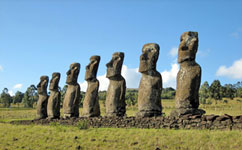
© UnknownEaster Island figures
This means that societies developed in incremental steps: small family groups would have developed into tribes, then chiefdoms, then more complex chiefdoms, and so on, until finally reaching the complex societies most of us live in today.
Until now, many anthropologists making do with incomplete archaeological data, have simply assumed that societies grow step by step, from simple tribe to chiefdom, to complex state.
But others have questioned the simplicity of this argument, saying that social systems are far too varied to have evolved in such a sequential way.
So researchers led by Thomas Currie from University College London came up with a neat new approach. Rather than relying entirely on archaeological evidence, they looked at how the languages of 84 societies in Southeast Asia and the Pacific are related and combined this with information about the different cultures.
The researchers built family trees showing how the languages are related, then superimposed information about the structure of each society.
'Trees built using the similarities between basic vocabularies in different languages have been shown to be good indicators of population history,' write the authors in their study, published in
Nature.
Using this approach, they were able to figure out how the different societies had evolved from the same ancestral population, 'in the same way that biologists use genetic data to understand how species are related,' explains Currie.
They then applied six different models to this information to see how these societies might have evolved. 'We could 'reach back into the past' to see how societies have changed over time,' he adds.
Three of the models assumed that social organisation develops through sequential steps of increasing complexity; from tribe to chiefdom to state. Two of these models also allowed losses in complexity, either in small or big jumps.
In contrast, the other three models assumed that political complexity doesn't evolve in a step-by-step manner.
'We found the model in which both increases and decreases in social complexity are sequential is the best fit, with the models that also allows societies to fall back to less complex forms the second best fit,' says Currie. 'The other models didn't fit the data well at all.'
The team's findings demonstrate that developments in political complexity in these societies evolved, without big jumps between different levels of organisation.
The researchers say this process of incremental change is similar to biological evolution.
The ancestors of people living in Southeast Asia and the Pacific today originally came from Taiwan around 5200 years ago. They rapidly spread to the islands of Southeast Asia, into Oceania, eventually reaching Madagascar, Hawaii, Easter Island and New Zealand.
The findings show that the earliest societies in Taiwan were likely to have been politically fairly simple with the earliest societies around Oceania being similar. In ancient societies around Oceania, it also seems that leadership didn't extend beyond the local community. These results tie in with archaeological evidence that shows small-scale settlements in this region.
Simple chiefdoms in the first Micronesian and Polynesian societies followed. These then developed into the more complex chiefdoms of Tahiti, Hawaii and Tonga. But several societies look like they may have decreased in complexity.
'Our study highlights the benefit of using the same techniques used to study nature to investigate human social and cultural evolution,' write the authors.
Thomas E. Currie , Simon J. Greenhill, Russell D. Gray, Toshikazu Hasegawa & Ruth Mace, Rise and fall of political complexity in island South-East Asia and the Pacific, Nature
, published online 13 October 2010, doi:10.1038/nature09461
you are stating the obvious. Since they were built sequentially they will go down sequentially. But simple societies come and go too, maybe in a different manner and for different reasons.